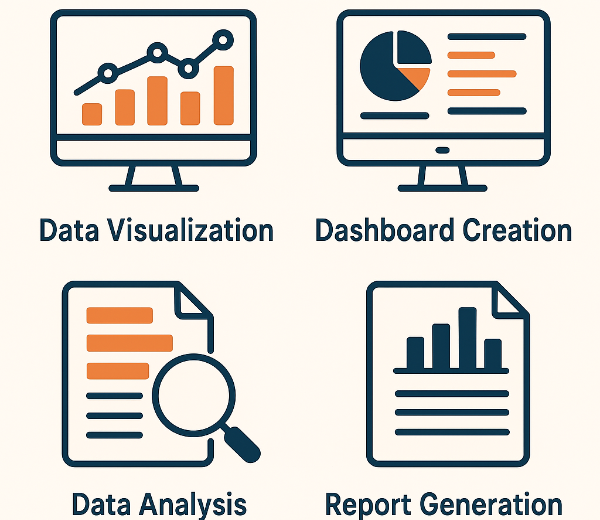Introduction
Business intelligence (BI) is an important component of any contemporary organization. BI entails gathering, arranging, and processing data to give useful information for making wise decisions. With more and more data being available, BI has been a vital asset for businesses that are willing to be competitive. Nevertheless, for one to effectively use the BI tools, he/she should have experience and knowledge. To improve at this, there are some exercises you can attempt. These will not only improve your analytical skills but also introduce you to various BI tools and methodologies.
Why Business Intelligence Skills Matter in Today’s World
Business Intelligence (BI) proficiency has been increasingly sought after in today’s data-based and fast-speed economies. BI is simply the gathering, analyzing, and reporting of information in an attempt to assist companies to make informed decisions. BI helps companies to gain knowledge regarding their business, customers, and market trends that are converted into improved decision-making and performance.
In the last few years, there has been an explosion of data because of the huge consumption of technology and digital media. Therefore, businesses are faced with a deluge of data that must be processed and analyzed in a short time. In this regard, BI skills come into prominence – they enable one to handle and leverage data to make intelligent decisions.
Unlocking the Power of Business Intelligence Through Practice

While it is critical to know business intelligence with strong theory, equally important is practicing that theory in real life. By actively working on applying BI tools and methods, one may master the skill and learn about data analysis.
One of the best ways to build BI skills is through training sessions or workshops where experience with real data sets can be obtained. Not only will this improve technical capability, but also problem-solving ability and critical thinking.
Moreover, work on personal projects on a regular basis or participation in online competitions can prove highly beneficial when it comes to obtaining hands-on experience. These actions allow one to try out different types of data and apply different methods of analysis, something that helps them better comprehend the strengths and limitations of BI tools.
Data Cleaning and Preparation Exercises:
In addition to these, BI professionals must also do data cleaning and preparation exercises. These include the identification and resolution of missing or incorrect data, data formatting for consistency, duplicate entry handling, and making the data ready for analysis.
These exercises not only enhance technical abilities but also aid in the formation of a critical eye for the identification of potential mistakes in datasets. This is an important ability since even minute mistakes can make a huge difference in the accuracy of analysis and the derived conclusions.
Practice Effective Data Visualization Techniques
After data cleaning and preparation, they then come to be presented in meaningful form through a second stage referred to as data visualization. Visualization is how data is being represented in graphic or visually distinguishable form, i.e., chart, graph, or map. Visualization enables one to notice trends, patterns, and relation from data easily.
Effective data visualization is the best way to share findings and insights with others. It also uncovers hidden relationships or patterns that are not necessarily evident when looking at raw data.
Some of the most important things to keep in mind when making data visualizations to be useful are choosing an appropriate type of graph or chart to use for data to be plotted, giving correct labels on axes, using high-quality color so categories or groups may be easily distinguished, and not overloading and having features which are redundant.
There are numerous available tools to make visualizations of your data, from simple spreadsheet software to specialized programs for this specific use. Select a tool depending on your proficiency level and needs.
Practice Effective Data Visualization Techniques
Once you have selected a tool, it is important to practice effective data visualization techniques. This includes choosing the appropriate type of chart or graph for the data being presented, labeling axes clearly, using colors effectively to differentiate between categories or groups, and avoiding clutter and unnecessary elements.
Choose the Appropriate Type of Chart or Graph
There are several forms of graphs and charts, and each has its advantages and disadvantages. The most commonly known are pie charts, scatter plots, bar graphs, and line graphs. Make sure to choose that which is most precise of your data and will be understood best by viewers.
For example, if you compared the number values between various categories or over different time frames, a bar chart or line chart would be better. If you wish to show the proportion of contribution that each category provides in the overall contribution, then a pie chart would be appropriate.
Remember also your audience and what type of visual representation they would most effectively respond to. For example, if your audience is very analytical, a labeled data point scatter plot would be more effective than a colorful infographic with minimal text.
Also think about what tale you have in your data and choose the type of chart or graph that will best convey that tale. Presentation graphics are to emphasize and support your argument, not hide it.
Apply BI Skills to Practical Business Scenarios

Data visualization becomes an important role in decision-making in the present business environment. Whether it means comparing sales records, monitoring activities of customers, or finding market trends, data visualization assists business organizations in comprehending intricate details and making rational decisions.
A practical instance where BI capabilities can be utilized is marketing campaigns. With the help of graphical representation of the consumer groups and buying behaviors, organizations can organize their marketing efforts in a manner such that respective groups of customers can be targeted best. This can mean increased conversions along with improved ROI.
One of the other areas where BI competencies can be utilized is in supply chain management. By designing interactive dashboards that present current data on production processes and inventory levels, companies can streamline their supply chain effectiveness and save money.
Measure What Truly Matters for Business Success
Business intelligence is not just collecting information and putting it in front of people in a pretty way. It’s about applying that data and making good decisions and impacting business success from it. Metrics need to be measured in ways that are correct in order to arrive.
One of the most common metrics that firms usually monitor is revenue growth. Although certainly important, it’s also vitally important to track customer satisfaction, employee motivation, and operational effectiveness. These metrics give great insight into the general well-being of the company and can be used as indicators that changes are necessary in some areas.
With today’s fast-paced business environment, being flexible enough is the secret to beating the herd. Corporations can monitor figures in real-time using BI tools and alter their direction if needed. This provides them with the ability to react better to changes in the market, customers’ expectations, and trends in the marketplace.
Communicate Insights to Stakeholders Effectively
Beyond monitoring metrics, BI programs also contain visualizations and reports that enable stakeholders to understand complex data. This enables companies to effectively communicate and make decisions on strategic actions towards the achievement of their goals.
In addition, BI tools have the capability to break silos in an organization since they provide each stakeholder with one platform on which to analyze data. Through it, different departments and teams can collaborate more and make more informed decisions based on the same business understanding.
Empower Employees with Self-Service Analytics
BI software also has self-service analytics capabilities, by which any type of employees in the organization can see and analyze the data without technical knowledge. It not only saves time and resources, but it also encourages a data-informed decision-making culture in the organization.
Self-service analytics allows employees to examine, visualize, and create reports independently. It reduces the wait time for IT or data analysts to finish data request filling so that their time can be utilized better on higher-level work. It also empowers non-technical users to just view and glance at data, leading to faster decision-making.
Create End-to-End Business Intelligence Projects
Apart from promoting data-driven culture, self-service analytics enables organizations to provide end-to-end business intelligence (BI) projects. Such projects involve applying data to inform major decision-making and company initiatives.
By self-service analytics, employees will be able to take ownership of such BI projects by gathering and analyzing data independently. This allows them to determine findings, make decisions on their own, and monitor the success and progress of their project.
By using end-to-end BI initiatives, organizations can gain the advantage of different perspectives and thoughts by involving their employees. This not only yields richer outcomes but also fosters collaboration among employees.
Conclusion
Briefly, self-service analytics is a platform that can revolutionize business intelligence management of corporations. Through offering employees direct access to analyze data, it makes the BI process more streamlined and encourages a culture of data-driven within the corporation.
With self-service analytics, organizations can get the maximum out of their data and are in a better position to understand their business, customers, and market trends. This leads to better decision-making as well as efficiency and thus gives them an edge in the market.



